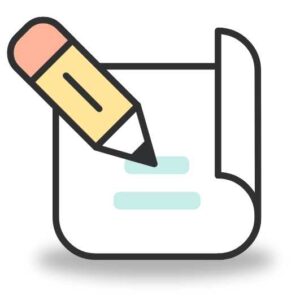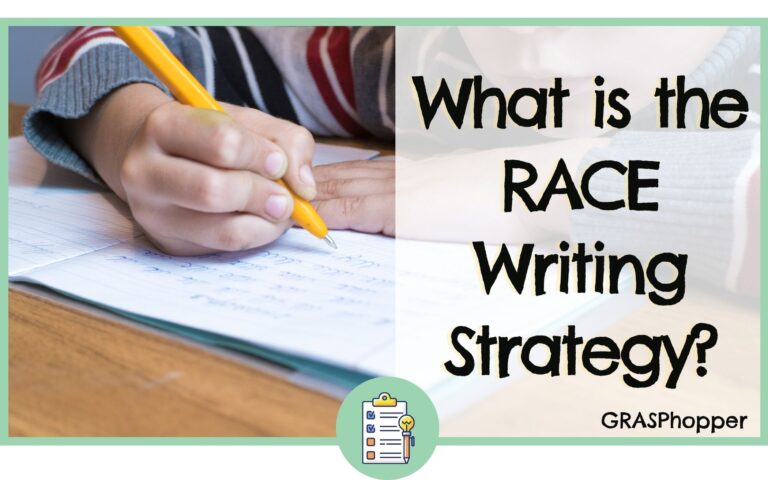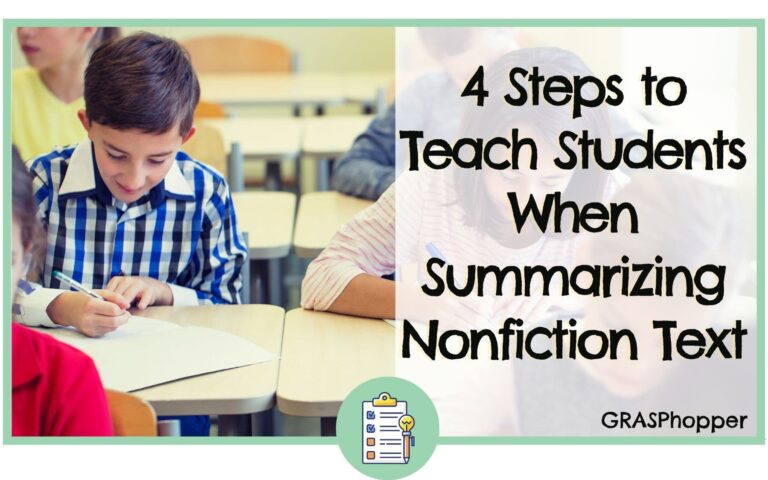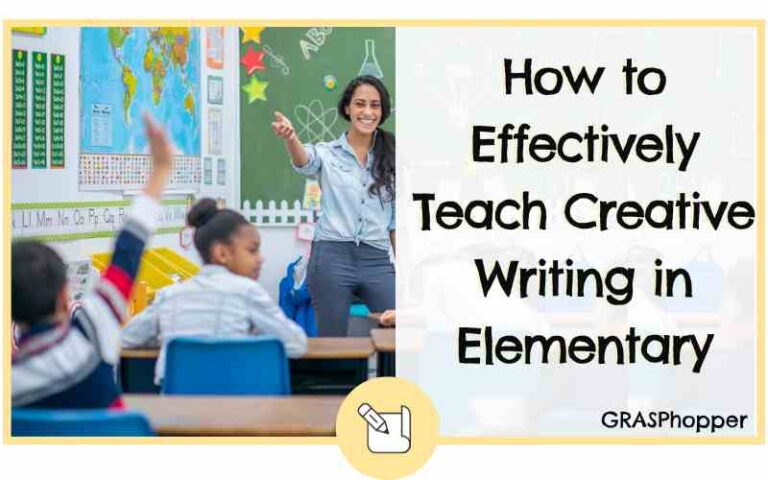Is this a fact or opinion sentence?
Teaching a fact and opinion lesson to elementary students is challenging.
It’s an…Opinion! Understanding facts and opinions is definitely one of those skills that seems super simple, until you begin to teach it. These terms can easily trick students! However, through the years, we have found several fact and opinion lessons and activities that will help your students reach mastery with ease.

Why is fact and opinion important?
Fact and opinion is a common skillset found in many ELA standards. But exactly why is it important to teach? Understanding fact and opinion is important to developing critical and analytical thinking skills, in both reading and writing.
Understanding fact vs. opinion is key to reading and listening comprehension. Particularly with content related reading, students need to determine what the facts are. Is the writer speaking from their personal perspective or are they using true data that is currently available?
Knowing the difference between fact and opinion also comes in handy with writing. We often teach students to write opinion and persuasive pieces. Students have to be able to gather facts and formulate opinions in order to have solid arguments to support their claim.
Lastly, we know that students are exposed to a vast amount of information with cell phones and the internet, but if a student can’t tell the difference between fact and opinion, it will lead to loads of misinformation, confusion and potentially dangerous situations.
As teachers, fact vs. opinion can seem like a simple concept, but it often confuses students. Many times, the opinions we give are stated like facts. For example, saying “public transportation is the only solution to decreasing traffic on the road” sounds like a true fact. But in actuality, this is an opinion, as someone could easily counteract this claim (just ask any New Yorker).
Identifying a Fact
Before you jump into a lesson on fact and opinion, you want to make sure you have a solid and clear definition for students. So, what exactly is a fact? How can you teach facts to students?
Here’s how we explain facts to our students in a simple and clear way. A fact is a statement that can be proven. This can be proven through observation, measurements, events, numbers, and scientific information. It cannot be challenged, and it doesn’t change from person to person.
You can prove something is a fact by researching through a website, book, or video. This is also a great time to talk about reliable sources. Explain to students that they want to use verified sources, such as .gov or .edu websites.
We totally recommend having all this information on an anchor chart for students. Anchor charts help to keep learning accessible to your students. They can provide a visual for your students to refer to, help support independence when working, be a focus during classroom discussions, as well as be of use as a memory aid. You can get our free digital fact and opinion anchor chart here!
Identifying an Opinion
Just as you did for facts, you want to have a clear and simple definition of the term opinion for students along with an anchor chart or reference page.
We explain an opinion as someone’s thoughts, beliefs, or feelings. Opinions can vary from person to person, and your opinion can change over time.
There are some keywords that may signal a statement is an opinion. Here are a few examples:
- Feelings: love, hate, enjoy, favorite, dislike
- Adjectives: worst, best, interesting, boring, hardest, easiest
- Thoughts and Beliefs: think, prefer, always, believe, never
Again, we always recommend having all this information on an anchor chart for students. You can get our free fact and opinion anchor chart here!
How to Teach Fact and Opinion
Now that you know the foundational information you will share with students, it’s time to put together a fact and opinion lesson. We have a step-by-step guide to help you craft a well-rounded lesson!
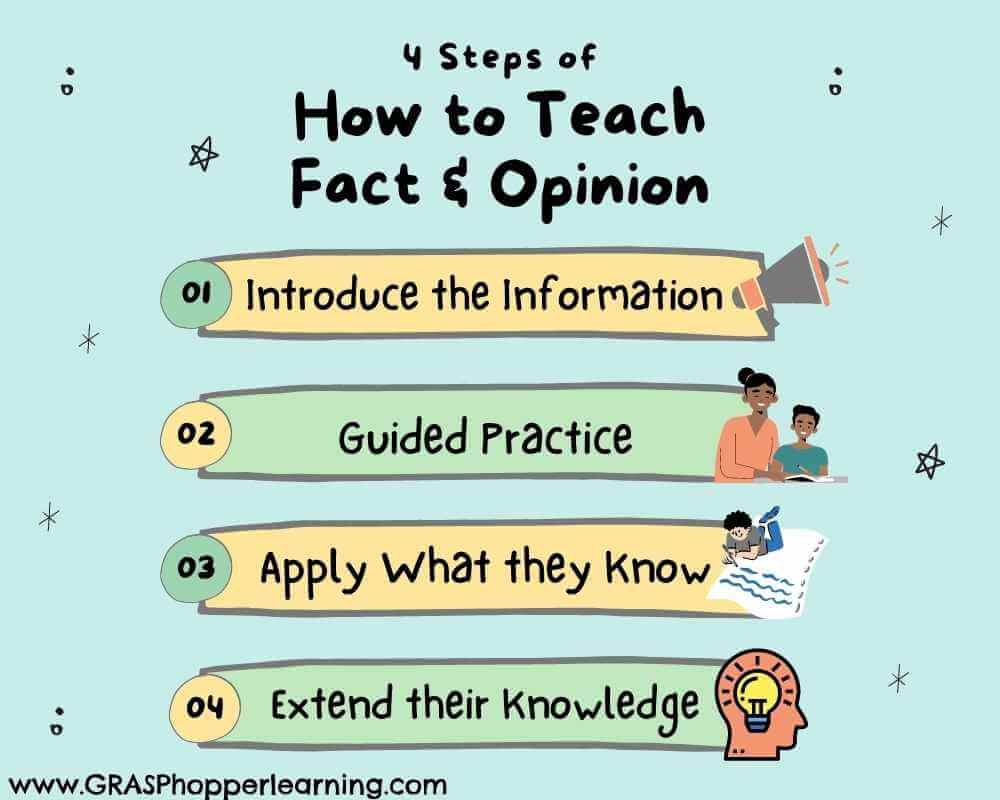
Step 1: Introduce the information
Begin by introducing students to facts and opinions. Give them the definitions and information we mentioned above. This would be a great time to walk through your anchor charts and have students write or paste information into their journals.
We also recommend using our YouTube video to teach fact and opinion! You can have students start by watching this video and review what they learned, or have them watch after your mini-lesson to reinforce the information. The video is chock full of practice opportunities along with direct teaching and models.
Step 2: Guided Practice
After your students are familiar with fact and opinion, it’s time to move on to a fact and opinion activity for practice. In guided practice, students can work in groups, partnerships, or at a small group with you, so you can assist them with the new content.
For guided practice, we recommend a task card sort. Have students look at an example of a fact or opinion given on the task card. Then, using the anchor charts, students will decide if the statement is a fact or opinion and why. By explaining their rationale, students are showing real mastery of the concepts.
We have a fact and opinion activity freebie you can use for this guided practice. It contains a digital anchor chart and task cards that are perfect for completing this activity. Get the fact and opinion freebie here!
Step 3: Apply What they Know
Now that students have practiced with others, it is time to practice independently. In this next fact and opinion activity, push your students’ knowledge further by having them apply it to a reading passage.
We recommend finding a reading passage that contains both facts and opinions. This can be a single paragraph or a whole passage. Have students read the passage and identify the facts and opinions throughout. You can push their knowledge even further by asking students to explain how they know it is a fact or opinion.
Exciting news-this type of activity is also available in our fact and opinion lesson freebie. Get the fact and opinion freebie here!
Step 4: Extend their Knowledge
Lastly, you want to challenge students to extend their knowledge outside of simple identifying tasks and reading. Now, students will begin creating! In this type of fact and opinion activity, students will write their own facts and opinions.
We like to do this by having students look at a picture or by giving them a topic. Then, they will generate a fact or opinion. At the beginning, students may only be able to write a sentence. As students’ skills get stronger, challenge them to write paragraphs.
We have several photo prompts ready to go in our complete digital and printable fact and opinion resource. The prompts are differentiated, so they can be used across your room. Some of the prompts contain a word bank, while others are open-ended. Choose which is best for your students!

Is this a Fact or Opinion? Teaching fact and opinion is easier now with these steps.

